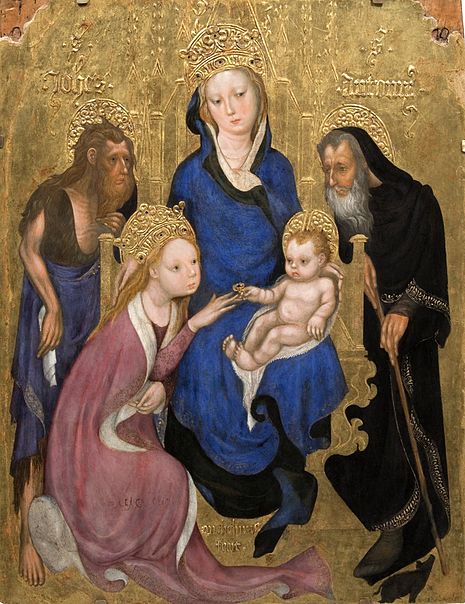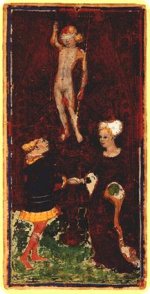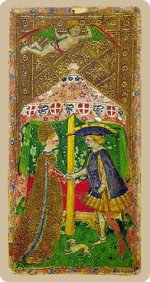Huck
Huck: It's interpreted, that it was a suggestion for a marriage deck (cause marriages were often ..
Ross: ..."often"?
Huck: ... connected to decks and Bianca was on her way to marry.)
Come on, we discussed it often enough and I earlier already gave a list. But if you wish:
Direct evidence:
1494: marriage Emperor Maximilian to Bianca Maria Sforza. Bride brought playing cards to wedding.
1496: Breitkopf gives a German copperplate deck as produced for the marriage of Maximilian's son and a Spanish princess.
Indirect or suggested evidence:
1487: (?) Lucretia marriage in Ferrara - Boiardo Tarocchi poem
1473 + 1474: Naples Trionfi card productions in the time, when the girls of the family marry (marriages 1473-1475-1476)
1473: in context of the marriage of Eleanor of Aragon to Ercole d'Este in Ferrara
1468: Bona of Savoyen - Galeazzo Maria Sforza
1465: ? Ferrarese production for Ippolito Sforza ?
1454: Intensive card production in Ferrara for marriage Tristano Sforza - Beatrice d'Este
1452: Production in Siena; marriage Emperor Fredrick to Eleanor of Portugal
1441: marriage Bianca Maria Visconti
Also of interest:
1430: Savoyen law, that man are only allowed to play cards with women (likely in the "courting situation)
ca. 1423: Van Eyck picture, that was used as copperplate-printing, showing 6 stages of Love in a love garden (courting ritual): 1 Drinking together, 2 Eating together, 3 Dancing together, 4 Playing cards together, 5 Making Music together, 6 man lies before the sitting woman
Is that enough to call it "often"? We don't have so much Trionfi card notes, so this is much.
Also we have such things:

This is from the wedding book Constanzo Sforza /Camilla Aragon. Naturally we don't know, if these pictures were made to playing cards ... but is this really interesting or SO IMPORTANT?
In the eyes of the living persons in 15th century the GREAT EVENT was the marriage, not the card deck, which possibly was produced to memorate the event. This was just a detail
So I don't understand your argumentation, when you say to "frescoes in the Palazzo Schifanoia":
Those frescoes are not triumph cards! What are you talking about here? The word "triumph" had and has a wide semantic range. The term "triumph" in terms of the card pack no doubt derives from one or some of the possible meanings of the term, but you can't just throw around references to everything under the sun that had some relationship with "triumphs" in the widest sense and think it proves something about triumph cards.
We research Trionfi cards.
But when we try to understand them, we've to place them in the context, where they once have been.
The same mind, who commissioned Trionfi cards and paid for them (and we listed these occurences), also commissioned the pictures of Palazzo Schifanoia. Both objects groups have the name "Trionfi" and now you wish to tell, that these things are not related?
Sorry, but relevant advances in research of these Trionfi card objects will probably only occur, when we research the surrounding of these productions.
In the case of Borso d'Este, who ordered the Palazzo Schifanoia and a lot of Trionfi cards (the most noted person in all early Trionfi documents) we have the feature, that he especially had a favour for the virtue "Iustitia" ...
... and then we've the feature for the Ferrarese order of the Trionfi cards, that in this deck type Iustitia had the number 20 in the row, so it is a "high Iustitia").
Taking here the right conclusion, we learn something about the cards, when we study Borso. But that's only one example.




